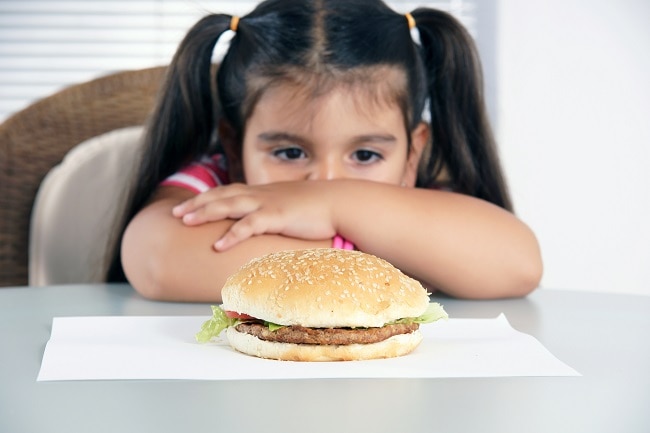My child hates meat! I’m worried about their nutrition.
During those inevitable picky eating stages, where macaroni and cheese may be the only suitable meal for breakfast, lunch and dinner as far as your child is concerned, you probably worry whether he or she is getting enough nutrients, particularly protein. Does your child’s diet need protein powders, bars or shakes to fill in the gaps?
Rest assured that despite picky eating, your child is likely getting protein through foods you might not expect. (Don’t forget, dairy sources have protein!) Additional protein supplementation, without warrant from a pediatrician, may just be leading to excessive weight gain or may be replacing other good nutrients.
What is protein?
Protein is one of three nutrients that provide calories (fuel) for the body. This macronutrient is considered to make up the “building blocks” of life since protein exists in all of our body’s tissues, muscles, bones, skin and hair. Protein is most commonly associated with meat foods but can be found in plant and dairy sources as well.
Why is protein important for kids?
Protein is a common nutrition concern for parents, especially because many children experience phases of not eating meat.
When eaten, protein keeps us feeling full. Once digested, protein breaks down into amino acids that become enzymes, transport carriers, hormones and structural components of our cells and membranes. These amino acids help to build our skin, muscles, bones and blood, which are essential for growing bodies.
Adequate protein is also important because there are nine amino acids that our bodies require but can only be obtained by eating protein foods. These amino acids include: histidine, isoleucine, leucine, lysine, methionine, phenylalanine, threonine, tryptophan and valine. This means that the greater variety of protein from plants and animal foods, the better the chance at obtaining all the essential amino acids.
What happens when kids don’t get enough protein?
Although in the U.S. and other developed countries, protein inadequacy is uncommon, those challenged by food insecurity may face greater difficulty meeting protein needs. Some sources estimate that even in the US, 1 in 7 school-aged children may be protein inadequate due to a larger portion of their food coming from sweets and other low-nutrient snacks. Signs that a child may not be eating enough protein can include delayed growth, decreased muscle mass, increased hunger, fatigue, slow wound healing, bone pain and difficulty concentrating.
In extreme cases, protein malnutrition called Kwashiorkor leads to growth failure, swelling and low immunity. Children with kwashiorkor often have a large, protuberant belly. The condition is rare in the U.S., but found more often in developing countries plagued by drought and famine.
So how much protein does my child need?
It is likely that your child is getting enough protein through foods, even if they turn away from meats. Think about your child’s food for an average day and check out if they are meeting their needs through one of the following methods.
- Calories from protein should make up about 10-30% of total calories for children 4-18 years old and 5-10% of total Calories for children 1-3 years old.
- Protein foods should make up about a quarter of each meal, three meals/day.
- Protein needs are determined by age according to the RDAs (Recommended Dietary Allowances).
|
Age |
Protein Needs |
|
1-3 Years Old |
13 grams/day (or 1.1g/kg of body weight daily) |
|
4-8 Years Old |
19 grams/day (or 0.95g/kg of body weight daily) |
|
9-13 Years Old |
34 grams/day (or 0.95g/kg of body weight daily) |
|
14-18 years old |
Girls- 46g/day, Boys 52g/day (or .85g/kg of body weight daily) |
*Not sure what your child’s weight is in kilos? Divide their weight in pounds by 2.2 and you’ll have the kilos! Example: A 5-year-old weighing 42 pounds would require about 18 grams of protein per day. 42lbs divided by 2.2= 19.1 multiplied by 0.95= 18.1 grams/day.
Where can I find protein in foods?
Unless otherwise directed by your child’s pediatrician or dietitian, take a “food first” approach to make sure your child getting the protein he or she needs. Even plant-based meal plans for kids can offer plenty of protein sources!
Plant-Based Proteins
1 slice whole wheat bread (4 grams)
½ cup beans (7 grams)
2 Tbsp. nut butter (7 grams)
½ cup peas (3 grams)
½ cup quinoa (6 grams)
½ cup shelled edamame (10 grams)
2 Tbsp. pumpkin seeds (4 grams)
2 Tbsp. hummus (2 grams)
Animal-Based Proteins
1 egg (6 grams)
2 oz. beef (12 grams)
2 oz. chicken (12 grams)
2 oz. tuna (11 grams)
2 oz. deli turkey (9 grams)
1 string cheese (6 grams)
1 cup milk (8 grams)
½ cup Greek yogurt (10 grams)
Kid-approved protein snacks:
- Top 4 crackers with 1 Tbsp. nut butter and banana slices (6 grams protein)
- Make mini kebabs out of cherry tomatoes and one sliced string cheese (6 grams protein)
- Spread mashed avocado over 1 oz. tortilla chips and sprinkle with ½ of a tuna pouch (9 grams protein)
- Serve mini egg salad sandwiches on whole grain bread using plain Greek yogurt in place of some mayo (1 boiled egg, 2 Tbsp. Greek yogurt, 1 slice bread = 13 grams protein)
- More of the best protein snacks
Protein power!
To put it into perspective, a meal featuring one slice of whole wheat bread, a scrambled egg, 2 Tbsp. shredded cheese and a cup of milk meets a 6-year-old’s protein needs for the whole day. For more information on supplements for kids and your child’s individual nutrition needs, check in with your nearest registered dietitian.

